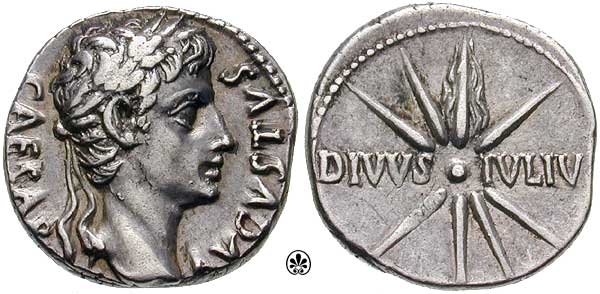

COMET OF THE WEEK
WEEK 22: MAY 24-30
“CAESAR'S COMET” C/-43 K1
Perihelion: 44 B.C. May 25, q = 0.22 AU
The biggest world event that year was the assassination of the Roman ruler Julius Caesar by several members of the Roman Senate on March 15 (the “Ides of March”). Caesar, who among other things was responsible for the development of the Julian calendar that governed affairs of much of the world for the next millennium and a half, had conquered and unified much of that part of the world into the Roman Republic. His assassination threw Rome into turmoil and led to several civil wars, but after several years his grandnephew and appointed heir Octavian successfully re-established order and took control as the first Emperor of the Roman Empire under the name Caesar Augustus.
Chinese and Korean astronomers reported the appearance of a bright comet during May of that year. The earliest reports date from May 18, and indicate that the comet was in the western sky, with a tail 8 to 10 degrees long. It traveled northward, and at perihelion on May 25 would have been only 11 degrees from the sun, and thus would have had to have been as bright as magnitude -2 or -3 to have been readily detected with the unaided eye; Chinese records indicate a tail 10 to 15 degrees long pointing towards the northeast. It went through conjunction north of the sun a few days later and emerged into the morning sky, and according to the Chinese records was last seen on June 16.
This deification of Julius Casear is described by, among others, the Roman poet/historian Ovid in Book XV of his Metamorphoses, where he has Jupiter saying to Venus (lines 839-849):

“He had barely finished, when gentle Venus stood in the midst of the senate, seen by no one, and took up the newly freed spirit of her Caesar from his body, and preventing it from vanishing into the air, carried it towards the glorious stars. As she carried it, she felt it glow and take fire, and loosed it from her breast: it climbed higher than the moon, and drawing behind it a fiery tail, shone as a star.”
Somewhat more recently, William Shakespeare, in his play Julius Caesar, has Caesar’s wife Calpurnia say to him on the fateful morning of March 15 (Act II, Scene 2):
“When beggars die there are no comets seen;
The heavens themselves blaze forth the death of princes.”
Astronomers have had a difficult time reconciling the Chinese reports in May with the later Roman reports, and for a time there was thought that the reports might be referring to two separate comets. Some scholars had originally dated the Ludi Victoriae Caesaris as having occurred in September, but more recent dating places them in late July. This earlier dating does help in reconciling the reports, as it allows the positional data (such as it is) to be fit by a reasonably valid orbit, but there is the obvious difficulty that, for the reports to be believed, a comet two months past perihelion passage would have had to have suddenly burst into daylight-visible brightness. The most widely accepted explanation is that the comet had faded more-or-less normally as it receded from perihelion, but then underwent a major outburst of several magnitudes in late July, most fortuitously near the beginning of the Roman festival.
Several historical and astronomical scholars have researched this, and although this remains the generally-accepted explanation, there remains some skepticism about the Roman reports, with some scholars even venturing the idea that the comet’s “appearance” during the Roman festival was nothing more than an after-the-fact propaganda ploy developed by Octavian and/or his associates. (For whatever it’s worth, the comet – at least according to the uncertain given orbit – never came close to Earth, with minimum geocentric distances of 0.96 AU in mid-May and just under 1.0 AU near the beginning of August.) Whatever might have really happened would seem to be lost within the mists of time.
“Comet of the Week” archive
Ice and Stone 2020 home page
Earthrise Institute home page